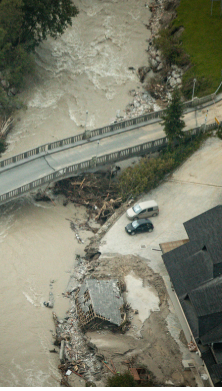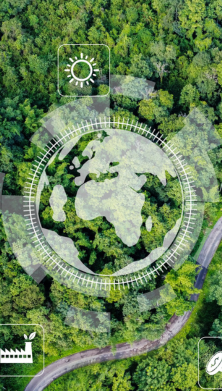Climate change falls two positions in this year’s Allianz Risk Barometer as the risk concerns of respondents are superseded by the Covid-19 pandemic. The virus represented an immediate threat in 2020 – for both individual safety and businesses, so, it is unsurprising pandemic outbreak has rocketed up the rankings at the expense of other perils. And it will likely remain a priority risk through 2021 until vaccination comes into effect and businesses can return to a post-pandemic new normal.
What the pandemic and climate change have in common is that they are both global systemic risks. However, compared to Covid-19, climate change is a catastrophe in slow motion with many causes and effects. While the virus may have inadvertently led to a minor reduction in emissions in 2020 due to less traffic, travel and industrial activity, the need to combat and prevent climate change and global warming remains as high as ever, as a series of recent unwelcome milestones underline.
The past six years have been the hottest since records began, with 2020 being both the hottest in Europe and the joint hottest year ever recorded, according to Europe’s Copernicus Climate Service [1] . In addition there were record-breaking hurricane and wildfire seasons in North America and Australia respectively, while California saw its first “gigafire”. At the same time, severe thunderstorms and storms in Europe and North America, often with hail or tornadoes, are becoming more frequent, with damages increasing, even after adjusting for value growth.
“2020 was the year of the pandemic; in 2021, climate change will be back on the board agenda as a priority,” says Michael Bruch, Global Head of Liability Risk Consulting/ESG at AGCS. “Climate change will require many businesses to adjust their strategies and business models in order to move to a low-carbon world. Risk managers need to be at the forefront of that change to assess the transition risks and opportunities related to market and technology shifts, reputational issues, policy and legal changes or physical risks. They have to help identify possible scenarios or evaluate the business and financial impact driving the overall low-carbon transformation of a company, together with other stakeholders.”

Recovery, risks and resilience
It is essential that the extensive policy measures for economic recovery and stimulus packages following Covid-19 meet both the recovery of the economy and the goals of the Paris Climate Protection Agreement – the target of which is to keep the increase in global average temperatures to well below 2°C above pre-industrial levels, and to try to limit the rise to 1.5°C.
It was not that long ago that climate-related strategies or goals were regarded as afterthoughts for many businesses. In future, it will likely be impossible for companies to be successful without them. Institutions such as the International Monetary Fund and the European Central Bank (ECB) see climate change as a significant financial risk that could even endanger the stability of the financial market, with “business as usual” scenarios leading to sudden and drastic corrections to “overvalued” fossil fuel assets.
Then there are a host of other drivers that are increasing the pressure on companies to be more climate-conscious: Ever more engaged employees keen to know their employer is doing the right thing environmentally; institutional investors such as pension funds and asset managers pushing for concrete measures to protect the climate, like CO2 reduction targets or an exit from the coal industry; shareholder groups ensuring climate issues are front and center at general meetings; and potential backers seeking more granular information on climaterelated strategies than ever before.
According to Allianz Risk Barometer respondents, the physical loss impact is the most significant exposure climate change creates for companies, followed by its impact on supply chains, customers and communities. Beyond the physical loss impact of damage from natural catastrophes or extreme weather events to business assets and property, there is also growing concern about how increases in global temperatures or greater flood risks in key locations could significantly affect future operations, facilities, workforces and communities and how to plan for such scenarios. Rising regulatory and legal risk is also a concern, particularly for high carbon-emitting sectors, but also elsewhere. Policy changes, new taxing schemes, reporting requirements and sustainability metrics are forthcoming. For example, the European Green Deal aims to make Europe the first climate-neutral continent by 2050 and comprises a Renewed Sustainable Finance Strategy. In the UK, there are plans to make climate-related financial risk disclosures mandatory for a whole swath of corporate Britain by 2025. Therefore, companies have to prepare and be able to adapt quickly.
At the same time, climate change activism is becoming both more sophisticated and professional. For example, non-profit law firm, ClientEarth, has gained a reputation for using legislation to hold companies accountable. In September 2020, it secured a major victory by forcing the closure of a giant coal plant in central Poland [2].
What are the most significant risk exposures its impact creates for companies?
Threat of litigation is also evolving. Climate change cases targeting “carbon majors” have already been brought in more than 30 countries, with the majority in the US. But climate attribution science opens up the prospect of legal action connecting individual events to climate change and holding companies responsible. Notably, a farmer has brought an action against German energy company RWE for its contribution to emissions, and potential damage to his property in Huaraz, Peru.
A crackdown on “greenwashing” – where companies provide misleading information so as to present a more environmentally-responsible public image – by regulators could also be on the cards in future with the Task Force on Climate-Related Financial Disclosures, the Securities and Exchange Commission (SEC) in the US and European supervisors looking into the issue.
As a result, climate change should not be classified just as a reputational risk, but also as a legal/governance risk. Companies’ boards of directors have a vital duty to ensure solid corporate climate responsibility with reporting and due diligence.
Investment in preparedness, mitigation and resilience is crucial. Company-specific climate risks and opportunities must first be identified, for example by using scenariobased analyses and tools and technology such as catastrophe models and hazard maps. These can help to develop a climate strategy that can be implemented with appropriate measures such as changes in business model or portfolio mixes or investments in capabilities and technologies, if required. Such changes could also constitute opportunities from a business perspective, as the energy transition brings new products and sales markets.
[1] Copernicus Climate Change Service, Global November Temperatures Reached A Record High, While Europe Experiences Its Warmest Autumn On Record, December 7, 2020
[2] ClientEarth, EU’s Biggest Coal Plant Must Negotiate Closure With Environmental Lawyers, September 22, 2020
Pictures: Adobe Stock
















